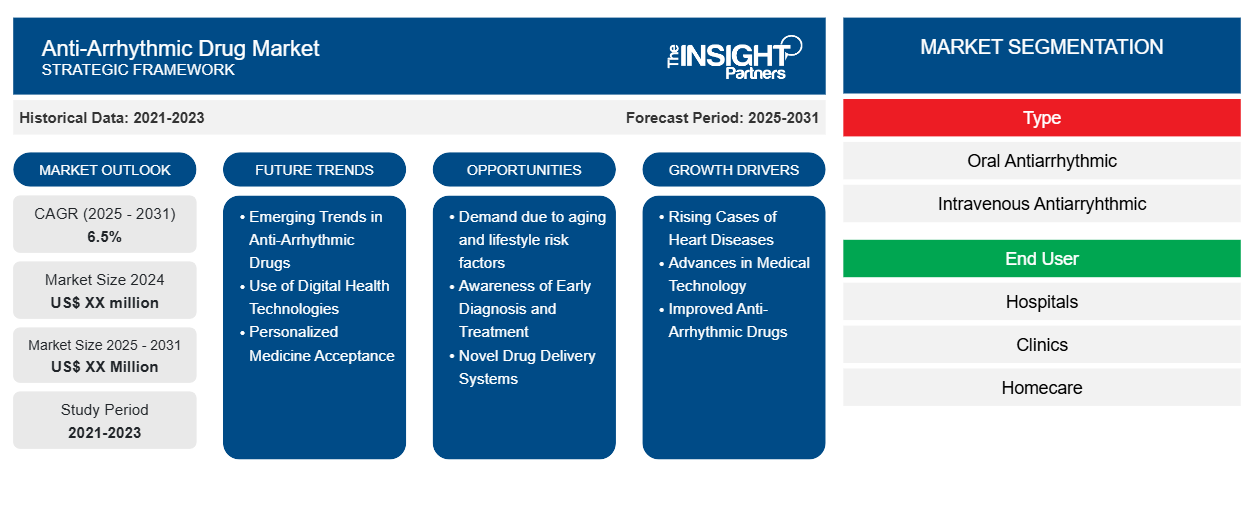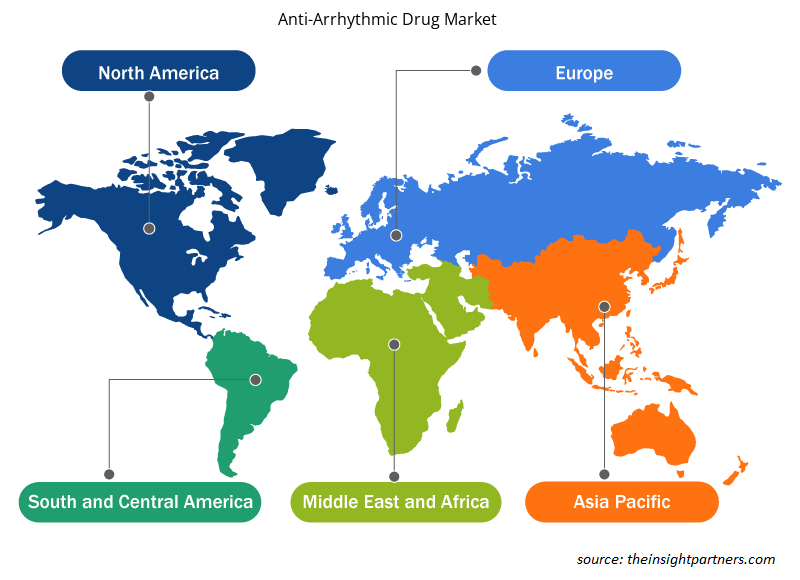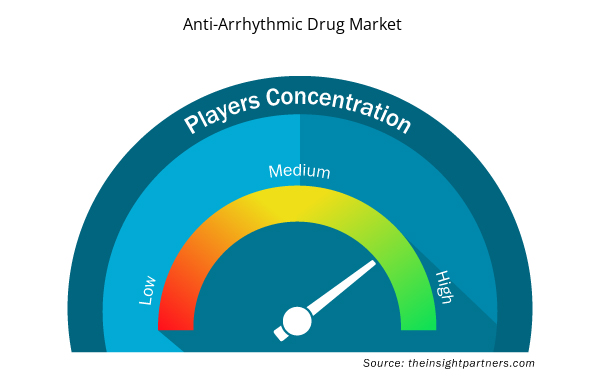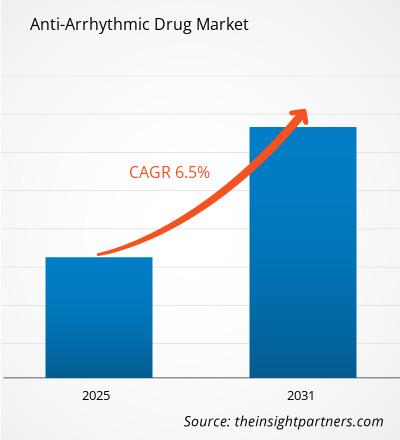The Anti-Arrhythmic Drug Market is expected to register a CAGR of 6.5% from 2025 to 2031, with a market size expanding from US$ XX million in 2024 to US$ XX Million by 2031.
The Anti-Arrhythmic Drugs market report is segmented by type into Oral Antiarrhythmic and Intravenous Antiarrhythmic. The end-user segment includes Hospitals, Clinics, and Homecare. The market evaluation is presented in US$ for the above segmental analysis. The global analysis is broken down at the regional level and major countries. The market evaluation is presented in US$ for the above segmental analysis.
Purpose of the Report
The report Anti-Arrhythmic Drug Market by The Insight Partners aims to describe the present landscape and future growth, top driving factors, challenges, and opportunities. This will provide insights to various business stakeholders, such as:
- Technology Providers/Manufacturers: To understand the evolving market dynamics and know the potential growth opportunities, enabling them to make informed strategic decisions.
- Investors: To conduct a comprehensive trend analysis regarding the market growth rate, market financial projections, and opportunities that exist across the value chain.
- Regulatory bodies: To regulate policies and police activities in the market with the aim of minimizing abuse, preserving investor trust and confidence, and upholding the integrity and stability of the market.
Anti-Arrhythmic Drug Market Segmentation
Type
- Oral Antiarrhythmic
- Intravenous Antiarryhthmic
End User
- Hospitals
- Clinics
- Homecare
Customize This Report To Suit Your Requirement
You will get customization on any report - free of charge - including parts of this report, or country-level analysis, Excel Data pack, as well as avail great offers and discounts for start-ups & universities
Anti-Arrhythmic Drug Market: Strategic Insights

- Get Top Key Market Trends of this report.This FREE sample will include data analysis, ranging from market trends to estimates and forecasts.
Anti-Arrhythmic Drug Market Growth Drivers
- Rising Cases of Heart Diseases: The most important reason for growth in the market is the rising cases of heart diseases, such as arrhythmia. An old age, sedentary lifestyle, and improper diet cause cardiovascular diseases, growing around the globe.
- Advances in Medical Technology: Market drivers in medical technology, advances along with some of the novel anti-arrhythmic drugs are estimated to drive growth in this market.
- Improved Anti-Arrhythmic Drugs: The newer anti-arrhythmic drugs are better at efficacy devoid of side effects or type-specific arrhythmias.
- Increased Awareness: Increased awareness related to diagnosing and treating arrhythmias during the initial phase is what is boosting this market.
Anti-Arrhythmic Drug Market Future Trends
- Emerging Trends in Anti-Arrhythmic Drugs: The trend for anti-arrhythmics is likely to be bright with much emerging trends forming this one. The first of the important trends is the discovery of new drug delivery technologies, including implantable devices and targeted therapies. These are aimed at better compliance from patients, as well as higher treatment efficiency.
- Use of Digital Health Technologies: The use of digital health technologies, including wearable devices and telemedicine, should improve the monitoring of patients and even allow for the remote management of arrhythmias.
- Personalized Medicine Acceptance: Further, acceptance of personalized medicines is also greater due to the fact that they can design individual-specific treatment plans based on genetic profiles and characteristics of diseases.
- Combination Therapies for Synergistic Benefits: The trend in today's combination therapies uses many anti-arrhythmic drugs for the combined synergistic benefits and more favorable clinical results.
Anti-Arrhythmic Drug Market Opportunities
- Demand due to aging and lifestyle risk factors: The rising population with increasing age, coupled with lifestyle-related risk factors, is enhancing the demand for effective anti-arrhythmic therapies.
- Awareness of Early Diagnosis and Treatment: The awareness of early diagnosis and treatment of arrhythmias is, in turn, widening new avenues for preventive intervention and therapeutic options.
- Novel Drug Delivery Systems: These novel drug delivery systems, including implantable devices and targeted therapies, open new avenues for further improvement in the patient's outcomes.
- Expanding Market in Emerging Economies: As healthcare infrastructure improves in emerging markets, there is increasing access to treatments for cardiovascular diseases. This opens up new opportunities for the anti-arrhythmic drug market, as more patients in these regions seek advanced treatments for arrhythmias and other heart conditions.
Anti-Arrhythmic Drug Market Regional Insights
The regional trends and factors influencing the Anti-Arrhythmic Drug Market throughout the forecast period have been thoroughly explained by the analysts at Insight Partners. This section also discusses Anti-Arrhythmic Drug Market segments and geography across North America, Europe, Asia Pacific, Middle East and Africa, and South and Central America.

- Get the Regional Specific Data for Anti-Arrhythmic Drug Market
Anti-Arrhythmic Drug Market Report Scope
| Report Attribute | Details |
|---|---|
| Market size in 2024 | US$ XX million |
| Market Size by 2031 | US$ XX Million |
| Global CAGR (2025 - 2031) | 6.5% |
| Historical Data | 2021-2023 |
| Forecast period | 2025-2031 |
| Segments Covered |
By Type
|
| Regions and Countries Covered | North America
|
| Market leaders and key company profiles |
Anti-Arrhythmic Drug Market Players Density: Understanding Its Impact on Business Dynamics
The Anti-Arrhythmic Drug Market market is growing rapidly, driven by increasing end-user demand due to factors such as evolving consumer preferences, technological advancements, and greater awareness of the product's benefits. As demand rises, businesses are expanding their offerings, innovating to meet consumer needs, and capitalizing on emerging trends, which further fuels market growth.
Market players density refers to the distribution of firms or companies operating within a particular market or industry. It indicates how many competitors (market players) are present in a given market space relative to its size or total market value.
Major Companies operating in the Anti-Arrhythmic Drug Market are:
- Novartis AG
- Merck and Co., Inc.
- Pfizer Inc.
- Astra Zeneca
- Johnson and Johnson Services, Inc.
Disclaimer: The companies listed above are not ranked in any particular order.

- Get the Anti-Arrhythmic Drug Market top key players overview
Key Selling Points
- Comprehensive Coverage: The report comprehensively covers the analysis of products, services, types, and end users of the Anti-Arrhythmic Drug Market, providing a holistic landscape.
- Expert Analysis: The report is compiled based on the in-depth understanding of industry experts and analysts.
- Up-to-date Information: The report assures business relevance due to its coverage of recent information and data trends.
- Customization Options: This report can be customized to cater to specific client requirements and suit the business strategies aptly.
The research report on the Anti-Arrhythmic Drug Market can, therefore, help spearhead the trail of decoding and understanding the industry scenario and growth prospects. Although there can be a few valid concerns, the overall benefits of this report tend to outweigh the disadvantages.
- Historical Analysis (2 Years), Base Year, Forecast (7 Years) with CAGR
- PEST and SWOT Analysis
- Market Size Value / Volume - Global, Regional, Country
- Industry and Competitive Landscape
- Excel Dataset


- Hummus Market
- Architecture Software Market
- Travel Vaccines Market
- Cosmetic Bioactive Ingredients Market
- Artificial Intelligence in Healthcare Diagnosis Market
- Ceramic Injection Molding Market
- Authentication and Brand Protection Market
- Aircraft MRO Market
- Predictive Maintenance Market
- Electronic Shelf Label Market

Report Coverage
Revenue forecast, Company Analysis, Industry landscape, Growth factors, and Trends

Segment Covered
This text is related
to segments covered.

Regional Scope
North America, Europe, Asia Pacific, Middle East & Africa, South & Central America

Country Scope
This text is related
to country scope.
Frequently Asked Questions
The leading players of the market are: Novartis AG, Merck and Co., Inc., Pfizer Inc., Astra Zeneca, Johnson and Johnson Services, Inc., Teva Pharmaceutical Industries Ltd., Eli Lilly and Company., Sanofi S.A., Bayer AG, GlaxoSmithKline plc
The report can be delivered in PDF/PPT format; we can also share excel dataset based on the request.
Some of the customization options available based on request are additional 3–5 company profiles and country-specific analysis of 3–5 countries of your choice. Customizations are to be requested/discussed before making final order confirmation, as our team would review the same and check the feasibility.
One of the key trends is the development of novel drug delivery systems, such as implantable devices and targeted therapies, to improve patient compliance and treatment efficacy. Besides this, the integration of digital health technologies, including wearable devices and telemedicine, is expected to improve patient monitoring and remote management of arrhythmias. Additionally, personalized medicine approaches are gaining momentum, which allow for tailored treatment strategies based on individual genetic profiles and disease characteristics. The increasing interest in combination therapies, with multiple anti-arrhythmic agents, is also likely to provide synergistic benefits and improved clinical outcomes.
Anti-Arrhythmic Drug Market is expected to grow at a CAGR of 6.5% between 2023-2031
There are many factors that push the global anti-arrhythmic drug market forward. Rising incidences of cardiovascular diseases, especially arrhythmias, contribute to the rising market trend. Growing populations, unhealthy dietary habits, and increased sedentary lifestyles increase the chances of having arrhythmia cases. Increased medical technological improvements and innovation of new drugs on anti-arrhythmic, having improved efficacy, with lesser side effects is driving this market further. The growing awareness of the early diagnosis and treatment of arrhythmias, combined with increasing healthcare expenditure, further drives market growth. The future of the anti-arrhythmic drug market is promising, with several emerging trends shaping its trajectory.
Trends and growth analysis reports related to Life Sciences : READ MORE..
1. Novartis AG
2. Merck and Co., Inc.
3. Pfizer Inc.
4. Astra Zeneca
5. Johnson and Johnson Services, Inc.
6. Teva Pharmaceutical Industries Ltd.
7. Eli Lilly and Company.
8. Sanofi S.A.
9. Bayer AG
10. GlaxoSmithKline plc

 Get Free Sample For
Get Free Sample For